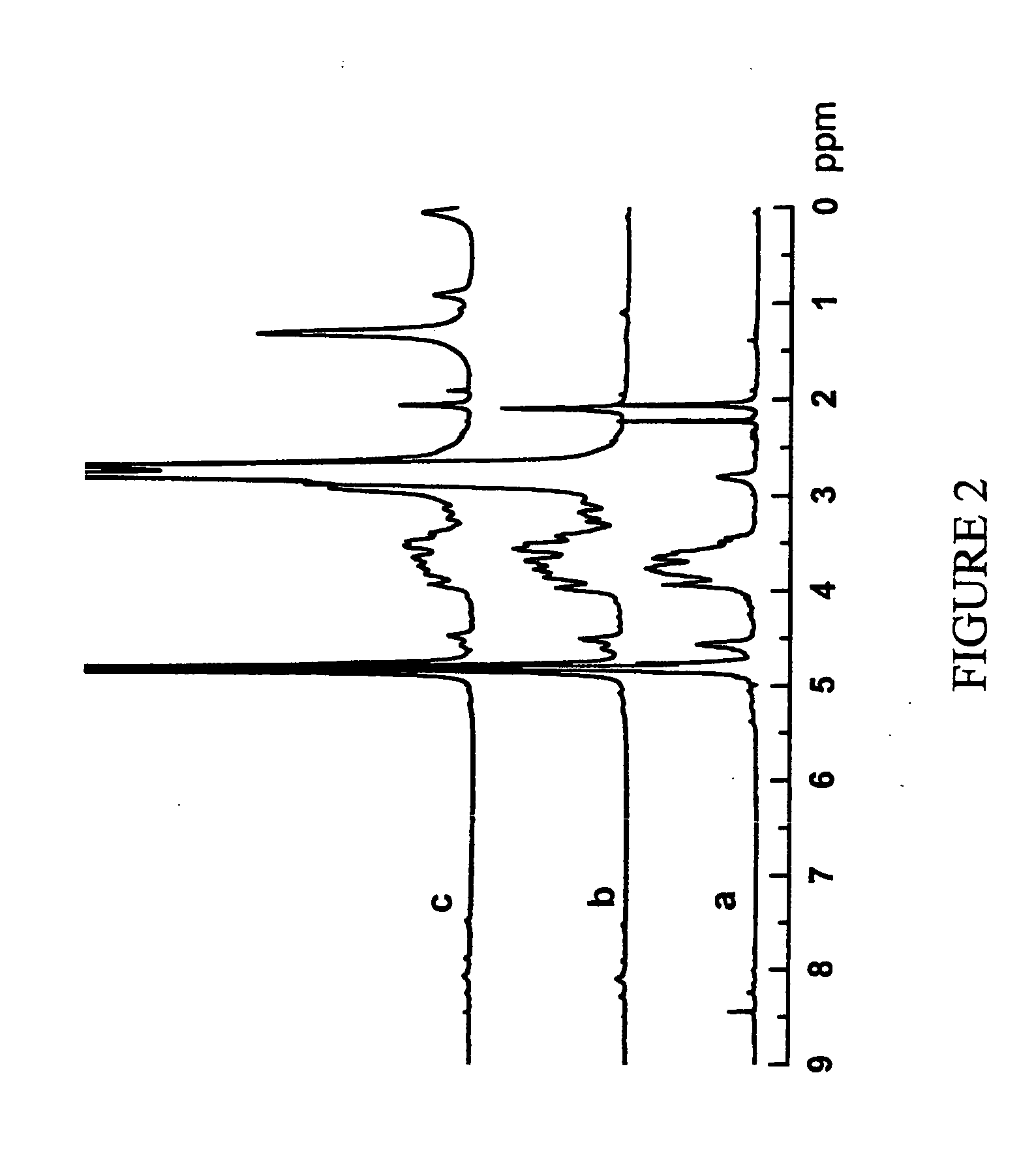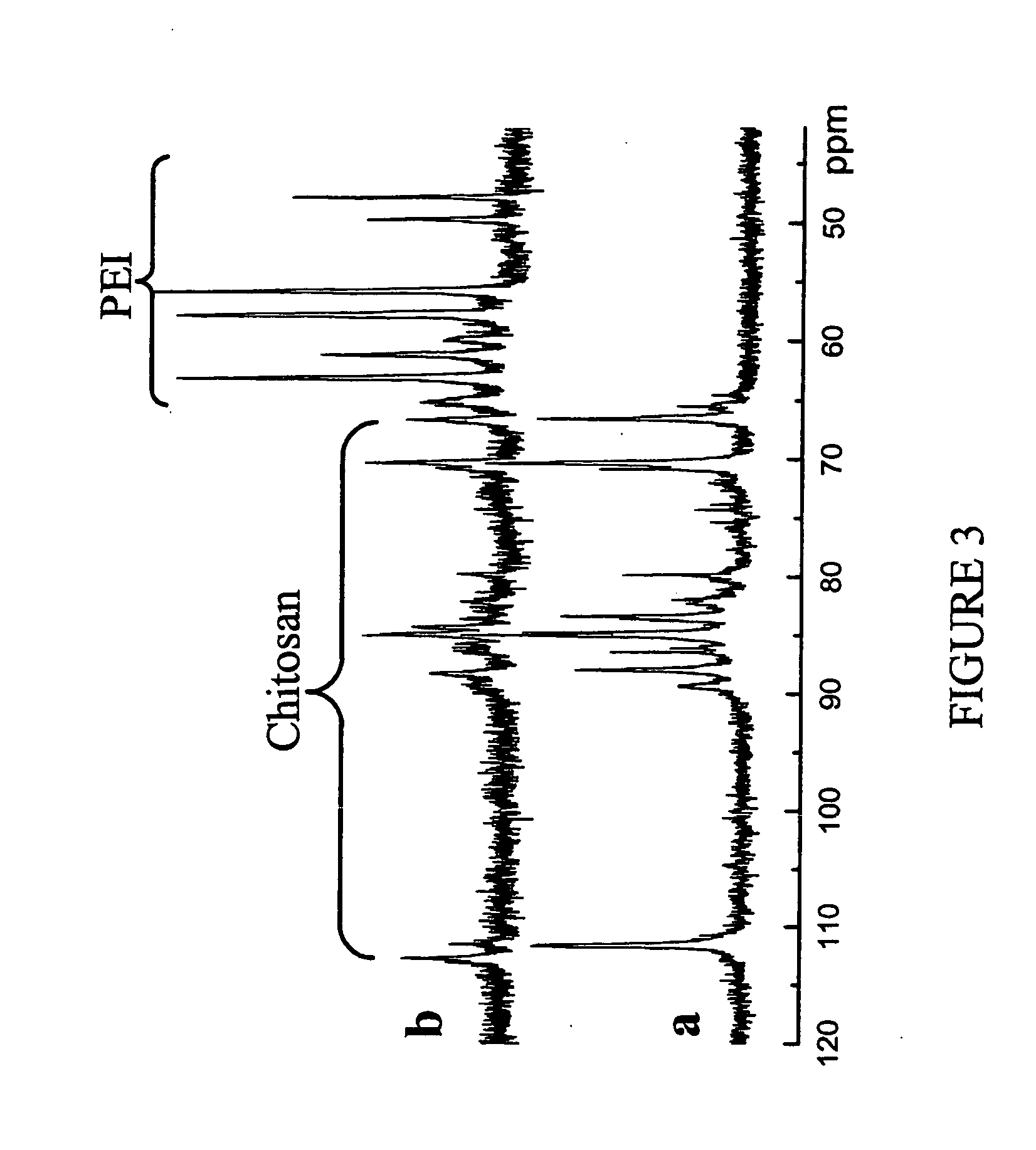Polyalkyleneimine-graft-biodegradable polymers for delivery of bioactive agents
a bioactive agent and polymer technology, applied in the field of polyalkyleneimine graft copolymer, can solve the problems of high immunogenicity of viral coat, difficult preparation of gene delivery vectors that are free of helper viruses, and the risk of viral-based gene delivery systems becoming replication competent and perhaps even pathogenic or tumorogenic, etc., to achieve the effect of gene therapy
- Summary
- Abstract
- Description
- Claims
- Application Information
AI Technical Summary
Benefits of technology
Problems solved by technology
Method used
Image
Examples
example 1
Synthesis and Characterization of PEI-Graft-Chitosan
[0130] 0.4 g of pure chitosan powder was dissolved in 5 ml of de-ionized water, and hydrochloric acid (HCl) with the molar ratio of HCl to amine in chitosan to be 1:10 was added. After ethyleneimine (EI) with molar ratio of EI to amine in chitosan to be 5:1 was added dropwise into the solution under stirring, the polymerization was performed at ambient temperature for 5 days. Finally, the temperature was increased to 60° C. for one day. After being purified by dialysis in water, the solution was lyophilized to give a light yellow powder.
[0131] The chemical structure of PEI-graft-chitosan was analysed by 1H and 13C NMR. FIGS. 1a and 2a show the 1H and 13C NMR spectrum of PEI-graft-chitosan respectively. From 1H-NMR spectrum (as shown in FIG. 1a), the ratio of PEI / the repeating units in chitosan is calculated to be around 4.8:1 close to the feed molar ratio, based on the integral intensities of peak located at 2.5-3.0 and 3.2-4.2 p...
example 2
Modification of PEI-Graft-Chitosan by Attaching Hexadecane.
[0134] 0.1 g PEI-graft-chitosan was dissolved in 4 ml chloroform. After exchanging with nitrogen by freezing and thawing for three times, 0.037 ml 1-idohexadecane was added after 0.02 ml triethylamine was introduced into the solution under stirring. The reaction was performed at 55° C. for 6 h followed by being kept at ambient temperature for 24 h. After removing chloroform, a powder was obtained. Then the powder was dissolved in 10% ethanol / water and purified by dialysis in 10% ethanol / water. A fine powder was obtained by lyophilization.
[0135]FIG. 1c is 1H-NMR spectrum of the hexadecane-graft-PEI-graft-PEI. The molar ratio of hexadecane / PEI is approximately 1:7 based on the integral intensities of peaks of protons of hexadecane and PEI at 0.7-1.5 ppm and 2.5-3.0 ppm, respectively.
[0136] GPC profile of hexadecane-graft-PEI-graft-chitosan is shown in FIG. 3c. Due to the attachment of hydrophobic long alkyl chains, hexadeca...
example 3
Formation and Analysis of DNA / PEI-Graft-Chitosan and DNA / Hexadecane—graft-PEI-Graft-Chitosan Complexes
[0137] Plasmid DNA (pCMV-Luc) was diluted to the chosen concentration (usually 0.5-2.0 μg / μl) in pure water under vortexing. Various amounts of 0.1 M solution of PEI-graft-polymer or hexadecane-PEI-graft-chitosan in water were added slowly to the DNA solutions. The amount of polymer added was calculated based on chosen N / P ratios of PEI-graft-polymer:DNA. After the solution was incubated at ambient temperature for 30 min with gentle vortexing, the formed PEI-graft-polymer / DNA polyplexes was mixed with a loading buffer and loaded onto a 1% agarose gel containing ethidium bromide. Gel electrophoresis was run at room temperature in TBE buffer at 80 V for 60 min. DNA bands were visualized by an UV (254 nm) illuminator.
[0138] The results of the agarose gel electrophoresis, shown in FIG. 4a, demonstrate that the migration of DNA was retarded completely when the N / P ratios of PEI-graft-c...
PUM
| Property | Measurement | Unit |
|---|---|---|
| molecular weight | aaaaa | aaaaa |
| molecular weight | aaaaa | aaaaa |
| molecular weight | aaaaa | aaaaa |
Abstract
Description
Claims
Application Information
 Login to View More
Login to View More - R&D
- Intellectual Property
- Life Sciences
- Materials
- Tech Scout
- Unparalleled Data Quality
- Higher Quality Content
- 60% Fewer Hallucinations
Browse by: Latest US Patents, China's latest patents, Technical Efficacy Thesaurus, Application Domain, Technology Topic, Popular Technical Reports.
© 2025 PatSnap. All rights reserved.Legal|Privacy policy|Modern Slavery Act Transparency Statement|Sitemap|About US| Contact US: help@patsnap.com



